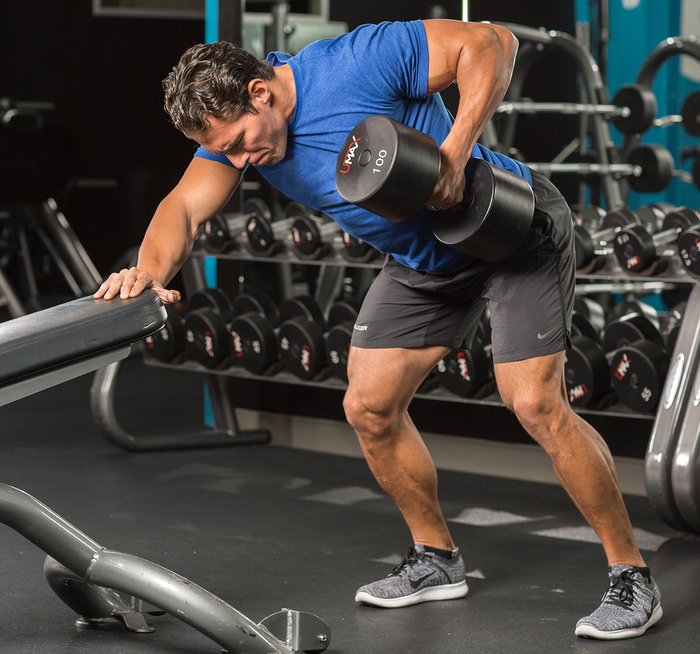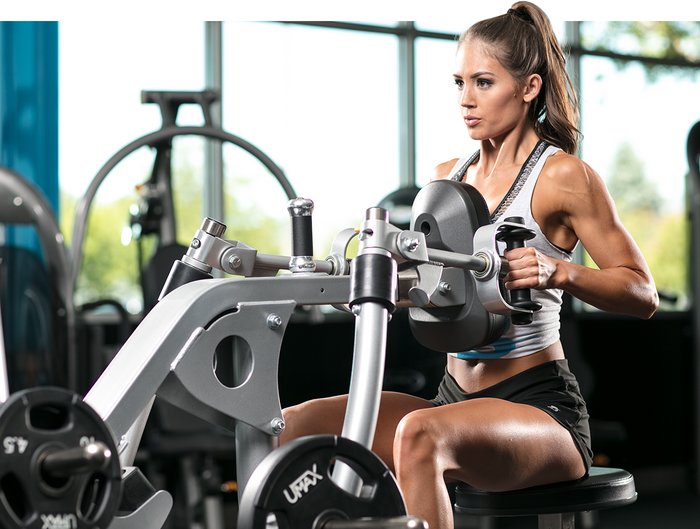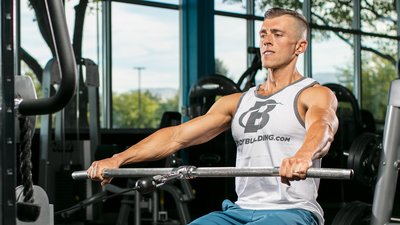There are many ways to do a row: with a barbell, dumbbell, cable, machine or suspension trainer, with one or two arms. Each is a great way to fight the "sitting position" while also helping you to build stronger, better-developed lats and mid-back muscles.
Regardless of which row variation you use, these general technique guidelines apply to help you get the most out of each rep:
- Maintain a stable spinal position with a normal curve throughout each rep.
- Pinch your shoulder blades together at the end of the concentric portion of each rep, and allow your shoulders blades to protract or spread at the end of the eccentric portion of each rep.
- Do not allow the front of your shoulders to round forward at the full row position (top of the concentric) of each repetition. In other words, a good row is not about how far your elbow goes back; it's about how far your shoulder goes back.
- Demonstrate deliberate control throughout the range of motion. Focus on the working muscles in each exercise, and maintain strict form without "cheating" by using additional movements or momentum.
Although the above technique guidelines apply to all row variations, different exercise applications and variations, by their nature (due to body position or execution), seem to best fit with certain rep ranges.
Here's my ultimate guide to programming rows. If you're a trainer or just someone who likes to think like this one, then this is for you!
Best Variations for Low Rep Ranges: 1-5 Reps
I use sets in the 1-5-rep range to train with a strength focus. The focus in this rep range is on performing the concentric portion of each exercise using as much force as you can. That means that although the weight is heavy and will force you to move slowly, the intention is to row the weight in as fast as possible without cheating the rep. Still, be sure to maintain a controlled eccentric (lowering) portion on each rep.
Barbell Underhand-Grip Row: I find this is the strongest grip for people to use, which makes it very conducive to use in this rep range. However, I've also found the supinated-grip position combats the common tendency to break at the wrists when doing overhand barbell rows with heavier loads. When the wrists break, the elbows get out of alignment and the row is no longer doing what it should.
Single-Arm Dumbbell Bench Row: I prefer a three-point stance, with both feet on the ground, instead of the convention two-point stance with your same-side knee on the bench. Reason being: The bench is always the same height, but people are of all different heights. So, depending on your height, with your knee on top of the bench, it can be awkward to keep your torso parallel with the floor, because you're trying to fit yourself to the bench.

On the flip side, with both feet on the floor, you can adjust the exercise to you, because you have full freedom to position your legs in a way that best fit your body and feels the strongest to you.
Single-Arm Free-Standing Row: Although many people think of the dumbbell bench row as the single-arm version of a barbell row, the freestanding dumbbell row is actually much closer to the barbell row than the bench-row version is. This is because without the additional support of using a bench, your glutes and lower back are both working harder.
However, the single-arm version works across your core—right shoulder to left hip, for example—making it a nice complement to the barbell row.
Machine High Row: Not all gyms have this machine, but I think every big-box facility certainly should. The rowing motion follows a natural arc that other rowing options don't quite replicate.
I've found the rowing motion it creates is difficult to do with bad arm alignment, which is a big reason why this exercise is one of my favorites to use in the low rep range.
Machine Horizontal Row: There's not much room for error when using a horizontal row machine, which is why I like it for working with heavy loads. In other words, keeping the basic rowing form cues in mind, there's not much else to focus on than going heavy on the weight stack, gripping it, and pulling.
Best Variations for Medium Rep Ranges: 6-12
All of my low-rep rowing choices also work well in a 6-12-rep range. But the opposite isn't quite true. If you're doing one of these heavy right now, you might be putting yourself behind the eight ball. Lighten up just a bit, and it could make all the difference.
Barbell Overhand Grip Row: I've found these work well in this rep range, because, unlike in the low rep range, there's not as much inclination to bend at the wrists and perform the row with poor arm alignment.
Wide-Grip Barbell Row: When it comes to rowing variations that focus on the mid-back musculature, wide-grip rowing variations are hard to beat. When doing wide-grip rows, the familiar cue of pulling the bar to—or "through"—the chest is something few can do without having to rotate their shoulders and wrists inward, and out of proper alignment, during the last couple of inches.
This common issue changes the training effect of the movement and takes the focus off of where it should be. Luckily, I've found it can be easily prevented by placing a fat-bar pad on the bar, then cueing to pull the pad—not the bar—up to your chest.
Seated Row: I think seated rows aren't a good fit to be used in the low rep range because of the exaggerated seated forward flexion that's require to start and finish each set. Combining this position with a heavy load doesn't makes sense from a risk versus reward perspective.
Wide-Grip Seated Row: This is another great exercise for targeting the middle back. Similar to using the barbell, I like to place a pad around the bar (Note: You won't be able to fully close the Velcro if the cable attachment point is in the middle, but it should still work more or less). Then, just pull the pad into your chest.
Single-Arm Cable Row: This is a great cross-body rowing exercise that also involves the core and the opposite hip of your rowing arm. Because you're standing, you're limited by how much you can hold without getting pulled forward, which has much more to do with your body weight than your strength level. This is why this exercise isn't a good fit to use in a low rep range.
Compound Cable Row (One and Two-Arm): This is one of my favorite rowing variations, because it involves moving the torso in conjunction with the arm motion, something which athletes tell me feels incredibly natural.
Done with one arm, it also involves a coordinated action with the core and the opposite hip. That said, since this is basically a variation of the cable row, the same loading limitations apply.
Half-Kneeling Single-Arm High Cable Row: This is basically the opposite of an incline press. Plus, for those who have trouble getting their rowing mechanics down, the angle of this row makes it a great option to emphasize in the early stages of programming.
Single-Arm Suspension Row: I like the double-duty ability of this exercise that trains core stiffness along with single-arm pulling strength. The goal is to keep the torso and hips from rotating as you perform the row.
To add to the antirotation demand, you can extend your free arm out to the side when doing this exercise. These are seriously tough for most people, so doing them for just 6-12 reps is probably going to present all the challenge you can handle.
T-Bar Barbell or Machine Row: T-bar rows are a classic exercise that really needs no explanation. That said, when doing the barbell version, as opposed to using the T-bar apparatus that some gyms have, I favor using a handle attachment that positions the hands at about shoulder-width apart, since it puts you in a better position when picking up or dropping the weight.
Best Variations for High Rep Ranges: 13-20+
Every exercise I've listed so far could also be used in this rep range. But these particular rowing variations work best when used in these higher rep ranges, for a variety of reasons.
Cable X-Row: This is basically a wide-grip row that creates a diagonal force vector, due to crossed cables, hitting the back muscles a bit differently than other wide-grip rowing options. This makes it a nice complement to the other wide-grip rowing options.
On the downside, it's very easy to do this exercise poorly. Especially if a weight is heavy, the wrists will start bending, and the elbows will drop. This is why I feel it best fits in a higher rep range.
Two-Arm Suspension Row: Although I'm not opposed to using two-armed suspension rows in a medium rep range, I think they work best at high reps, because I'd rather progress by doing more reps from the same body angle, about 45-degrees to the floor, instead of using a lower body angle. This is because the rowing motion becomes more awkward, and the pressing action gets altered when you go from a flat press to a decline press.
Wide-Elbow Suspension Row: Suspension rows are a solid choice either with elbows tight in or slightly flared. But in both cases, I prefer high reps.
Band Speed Row: Moving heavy and moving fast are both ways to increase motor-unit recruitment. Bands allow you to move fast. And, although we appreciate the need for moving fast when performing lower-body exercises and pressing exercises, it's always surprised me that it's not often something that's commonly done when performing rows.
Since the focus is on movement speed, I recommend trying to perform a full rep per second.
Alternate Arm-Band Speed Row: The alternate (reciprocal) arm option incorporates an element of torso rotation into the row, and combined with the movement speed, makes it one of the more athletic rowing options.
Again, since the focus is on movement speed, I recommend trying to perform one rowing cycle (both the left arm and right arm have performed a full row) per second.
How to Program Rows
I like to use a three-cycle undulating set/rep strategy like this:
- Workout 1: Medium rep range
- Workout 2: Low rep range
- Workout 3: High rep range
This works well repeated 4-6 times using the same exercises while progressively increasing the load demand each week. After 4-6 cycles, switch to different exercises, but use the same framework.
Below are four different permutations of the same undulating three-cycle. This could be enough to last you for months of solid training.

Version 1
- Row Workout 1: Seated row, 3 sets of 8-12 reps
- Row Workout 2: Single arm free-standing row, 4 sets of 4-5 reps
- Row Workout 3: Wide-elbow suspension row, 2 sets of 15-20 reps
Version 2
- Row Workout 1: Single-arm cable compound row, 3 sets of 8-10 reps
- Row Workout 2: Barbell underhand-grip row, 4 sets of 4-5 reps
- Row Workout 3: Band speed row, 2 sets of 25-30 reps
Version 3
- Row Workout 1: Horizontal row machine, 3 sets of 7-10 reps
- Row Workout 2: Single-arm dumbbell bench row, 4 sets of 4-5 reps
- Row Workout 3: Wide-grip seated row, 2 sets of 15-20 reps
Version 4
- Row Workout 1: T-bar row machine, 3 sets of 7-12 reps
- Row Workout 2: High row machine or horizontal row machine, 4 sets of 4-5 reps
- Row Workout 3: Cable X-row, 2 sets of 13-20 reps

